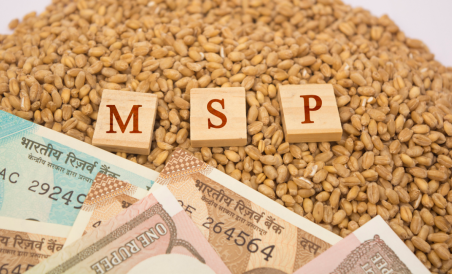Introduction
Minimum Support Price (MSP) is a form of market intervention by the Government of India to insure agricultural producers against any sharp fall in farm prices. The minimum support prices are announced by the Government of India at the beginning of the sowing season for certain crops on the basis of the recommendations of the Commission for Agricultural Costs and Prices (CACP).
The minimum support price (MSP) is an advisory price signal that is part of a larger set of agricultural policies in parts of India. This informal “support” price (as opposed to procurement or issue price) is recommended by the government and aims to safeguard the farmer to a minimum profit for the harvest while at the same time increasing food security in the country.
Historical Perspective of MSP
The Price Support Policy of the Government is directed at providing insurance to agricultural producers against any sharp fall in farm prices. The minimum guaranteed prices are fixed to set a floor below which market prices cannot fall. Till the mid 1970s, Government announced two types of administered prices :
- Minimum Support Prices (MSP)
- Procurement Prices
The MSPs served as the floor prices and were fixed by the Government in the nature of a long-term guarantee for investment decisions of producers, with the assurance that prices of their commodities would not be allowed to fall below the level fixed by the Government, even in the case of a bumper crop.
In the 1960s, India saw food shortages such as the Bihar famine of 1966–1967, resulting from droughts and war. During the prime years of the green revolution in India in that decade, a number of agriculture policy strategies were mooted including a government price policy for food grains. One of the main goals was to increase the productivity of agricultural land. High yield varieties, better equipment and fertilizers were among the strategies adopted. Price policy support aimed at increasing land productivity was part of this.
This led to the setting up of the Agricultural Price Commission (APC) in 1965. The Commission introduced a number of price policies including procurement at pre-decided prices, minimum support prices and a distribution system to supply food grains at subsidised rates.
Procurement prices were the prices of kharif and rabi cereals at which the grain was to be domestically procured by public agencies (like the FCI) for release through PDS. It was announced soon after harvest began. Normally procurement price was lower than the open market price and higher than the MSP. This policy of two official prices being announced continued with some variation upto 1973-74, in the case of paddy. In the case of wheat it was discontinued in 1969 and then revived in 1974-75 for one year only. Since there were too many demands for stepping up the MSP, in 1975-76, the present system was evolved in which only one set of prices was announced for paddy (and other kharif crops) and wheat being procured for buffer stock operations.
This body was reconstituted into the Commission for Agricultural Costs and Prices (CACP) in March 1985 with a new and broader terms of reference. A number of other institutions are involved in the process of implementing the MSP, including central organization along with their state level bodies. This includes the Food Corporation of India (FCI) and the National Agricultural Co-operative Marketing Federation (NAFED).
As per 2013 Ministry of Statistics data only 23% of farmers in the rural agricultural households in India are aware of MSP of crops. Awareness varies from 0 to 50% according to state. Even fewer are aware of an procurement agency buying at MSP. In 2018-19, a quarter of the total paddy sales and only 20% of wheat were sold at MSP. Attempts to ensure MSP is fulfilled have included the decades-old Price Support Scheme (PSS), the 2015 Decentralized Procurement Scheme (DCP), and more recently the 2018 umbrella campaign, the Farmer Income Protection Scheme (PM AASHA). Under AASHA, a price deficiency payment (PDP) system has been launched under which the government will partly compensate farmers for those who have had to sell their crops at market prices less than the MSPs. This could result in large savings for the government as it would not have to procure and store the crops.
Guaranteed MSP is one of the major demands of the 2020–2021 Indian farmers’ protest.
Commodities under MSP
A total of 23 commodities are covered by MSP mechanism:
-
Cereals:
- Paddy
- Wheat
- Maize
- Sorghum
- Pearl millet
- Barley
- Ragi
-
Pulses:
- Chickpea / Gram / Gramme
- Tur
- Moong
- Urad
- Lentil
-
Oilseeds:
- Peanut
- Rapeseed
- Soyabean
- Sesame
- Sunflower
- Safflower
- Niger seed
-
Commercial crops:
- Copra
- Sugarcane
- Cotton
- Raw jute
Determination of MSP
In formulating the recommendations in respect of the level of minimum support prices and other non-price measures, the Commission takes into account, apart from a comprehensive view of the entire structure of the economy of a particular commodity or group of commodities, the following factors:-
- Cost of production
- Changes in input prices
- Input-output price parity
- Trends in market prices
- Demand and supply
- Inter-crop price parity
- Effect on industrial cost structure
- Effect on cost of living
- Effect on general price level
- International price situation
- Parity between prices paid and prices received by the farmers.
- Effect on issue prices and implications for subsidy
The Commission makes use of both micro-level data and aggregates at the level of district, state and the country. The information/data used by the Commission, inter-alia include the following :-
- Cost of cultivation per hectare and structure of costs in various regions of the country and changes there in;
- Cost of production per quintal in various regions of the country and changes therein;
- Prices of various inputs and changes therein;
- Market prices of products and changes therein;
- Prices of commodities sold by the farmers and of those purchased by them and changes therein;
- Supply related information – area, yield and production, imports, exports and domestic availability and stocks with the Government/public agencies or industry;
- Demand related information – total and per capita consumption, trends and capacity of the processing industry;
- Prices in the international market and changes therein, demand and supply situation in the world market;
- Prices of the derivatives of the farm products such as sugar, jaggery, jute goods, edible/non-edible oils and cotton yarn and changes therein;
- Cost of processing of agricultural products and changes therein;
- Cost of marketing – storage, transportation, processing, marketing services, taxes/fees and margins retained by market functionaries; and
- Macro-economic variables such as general level of prices, consumer price indices and those reflecting monetary and fiscal factors.
The increase in MSP for Kharif Crops is in line with the Union Budget 2018-19 announcement of fixing the MSPs at a level of at least 1.5 times of the All-India weighted average Cost of Production (CoP), aiming at reasonably fair remuneration for the farmers.




